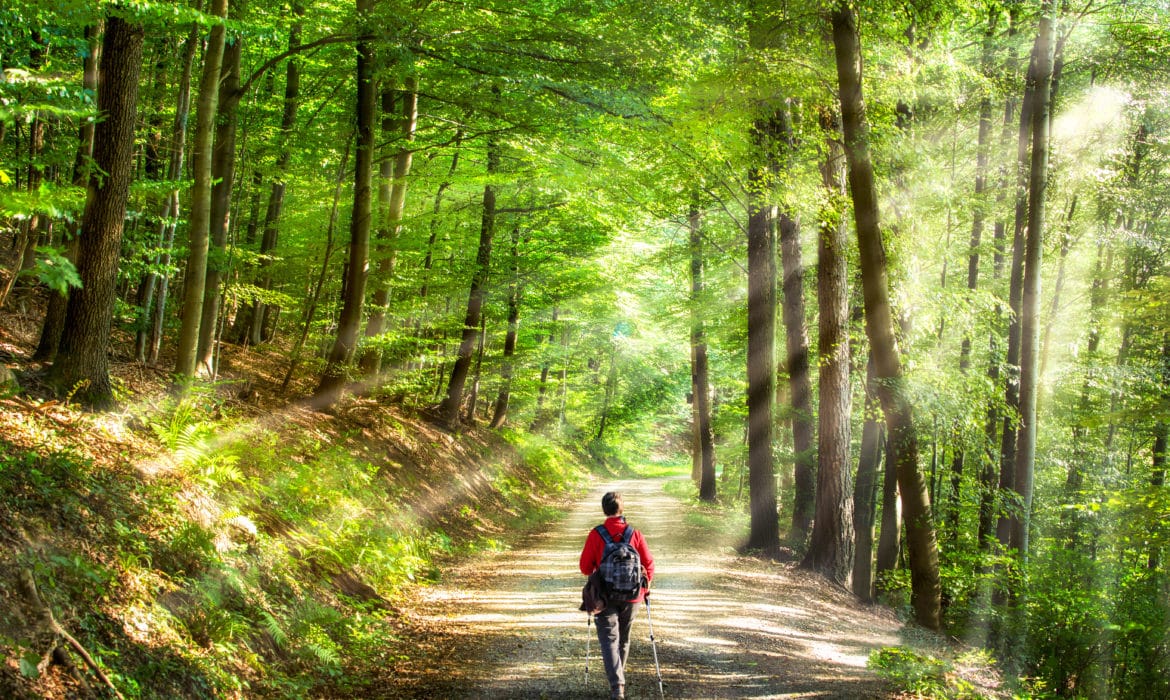Nature used to be an integral part of the lives of human beings. But today, our connection to Mother Nature is minimal.
“Most people in our society spend most of their time indoors, so we’re disconnected from our senses,” says Jodi Trendler, a certified forest therapist. “We don’t listen to what our bodies are telling us during the day, so at night we can’t get to sleep, the tension builds up and we ignore it. Over time we get headaches, carpal tunnel syndrome, stiffness and soreness, and we lose mobility.”
Taking healing, mindful walks in nature can increase sensory awareness and bring balance to our lives. Trendler, who conducts nature walks at The Morton Arboretum, is inspired by a practice developed in Japan in the 1980s called shinrin-yoku, which translates to forest bathing and is also sometimes referred to as forest therapy. It is based on the principle that a loving connection with nature can enhance preventive healthcare, well-being and healing.
Mindful walks
Forest walks are similar to the practice of mindfulness, Trendler says, but instead of focusing on breathing to experience a sense of calmness, participants in forest therapy focus their senses on nature to experience its healing power.
The walks are not designed as a time for physical exercise or as social occasions to chat with friends, she says. Instead, they are leisurely walks that can last for up to three hours.
Trendler asks participants to slow their pace and to stop now and then to focus one of their senses on a healing activity. For example, participants may be invited to walk silently and slowly like a fox. “It gives them a chance to listen to the sounds of nature and also slows down people’s breathing,” Trendler says. Participants may be asked to smell a flower, a leaf or perhaps a clump of soil. “The sense of smell reactivates the brain and often triggers memories from their childhood and makes them feel like a kid again,” she says.
Naperville resident Heiko Mitzkus, a business manager, has gone on the forest bathing walks at the Morton Arboretum several times. “It is a way to create some balance in our lives when we’re so busy and occupied by so many concerns,” he says. “It’s a time to switch off and just relax. I feel more connected to nature because I use all my senses.”
Health benefits of nature
Research on the health benefits of nature, in particular on the immune system, has been conducted in Japan, Korea, Taiwan and China. There is a growing interest in the influence of nature on health in the United States but not enough research, says Teresa Horton, PhD, an associate professor of research in the anthropology department at Northwestern University.
“There is so much discussion in the popular press about green space being good for your health. Parks and recreation groups are promoting the health benefits of nature, and doctors are being encouraged to write prescriptions for people to spend time in nature. But at the time I started my research, I couldn’t find any controlled research studies in the United States to document that regular exercise in natural areas leads to better long-term health outcomes than other forms of exercise,” Horton says.
So, Horton and a group of her colleagues, in collaboration with the Forest Preserve District of Cook County, conducted a study in 2016-2017 called “Walking Green: Developing an Evidence-base for Nature Prescriptions.”
For the project, a group of ethnically diverse men and women ages 18 to 35 were divided into two groups. One group took solitary walks without cell phones for 50 minutes three times in one week in a forest preserve; the other group took the walks on a city street. All participants took blood tests as well as a battery of psychological tests before and after each walk and had blood tests weekly. After a week off, the groups traded locations and repeated the walks.
The results showed the psychological and physiological health benefits of walking in the woods. “The stress levels and the anxiety levels of those who walked in the woods decreased, and their mood improved to a greater extent following a walk in the woods than on the sidewalk,” Horton says. “For those who had a high blood glucose level that indicated prediabetes, their blood glucose level had gone down five points 72 hours after the last walk. So while walking is good, walking in the woods appears to be better. We think that this might happen because stress interferes with glucose metabolism” and walking in nature lowers that stress.
The study’s results also suggested that you need to continue to get outside on a regular basis, Horton adds. The effects on mood, anxiety and stress did not carry over to the 72-hour follow-up.
Horton collaborates with Park Rx America, founded by Robert Zarr, MD, MPH, a Washington, DC, pediatrician who prescribes time in nature for his patients to prevent and treat chronic diseases and promote well-being. The organization’s website includes locations of green space nationwide.
Horton suggests that people find their own way to reap the benefits of Mother Nature’s eco-therapy.
“Nature comes in many forms for different people,” she says. “You don’t have to go off to Wisconsin or out to the Grand Canyon to get a wild adventure. You can go someplace where there are trees — a place that gives you a sense that you are away from your daily cares. Look at some trees or walk along the lake for five minutes a day. Make it to a forest preserve once a week, or you can even meditate with your potted plants to get a semi-forest bathing.”
Instead of going to the doctor for a medical prescription, your next prescription could very well be a nature one.












